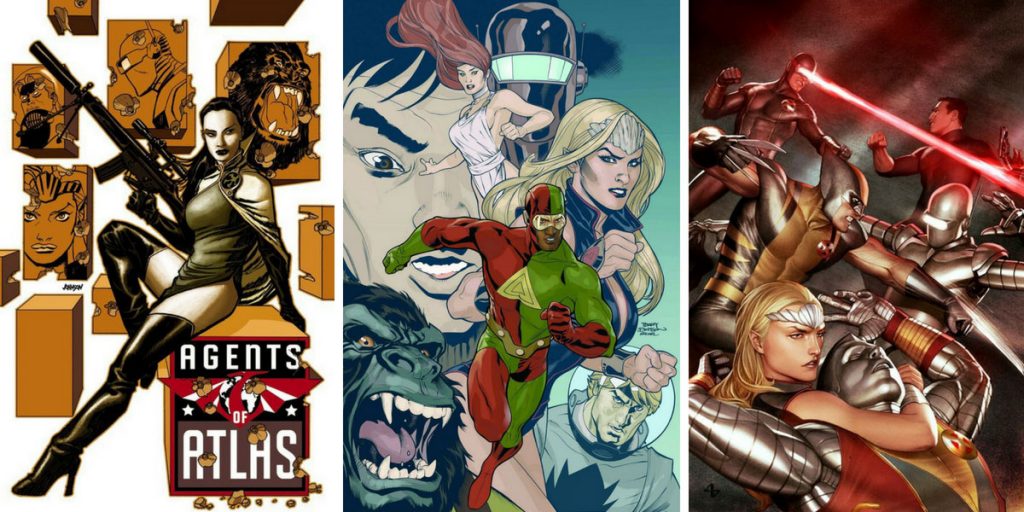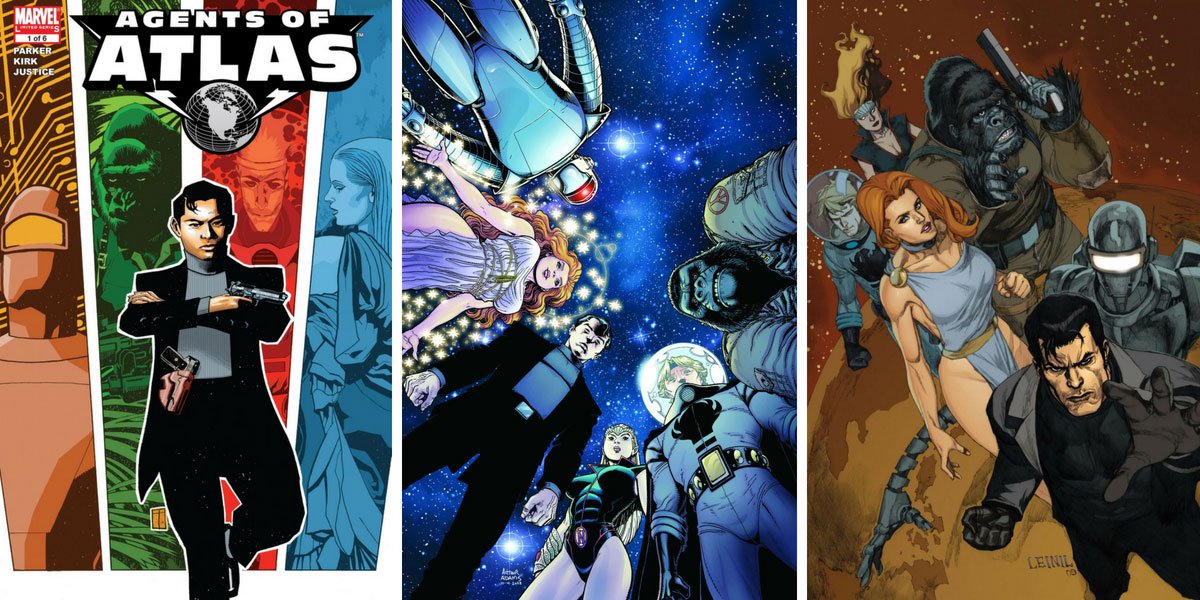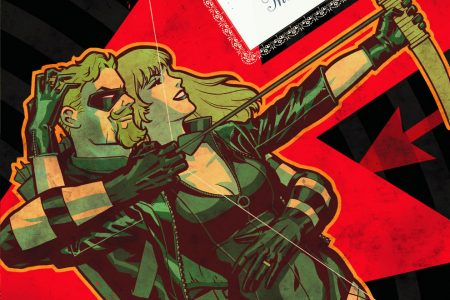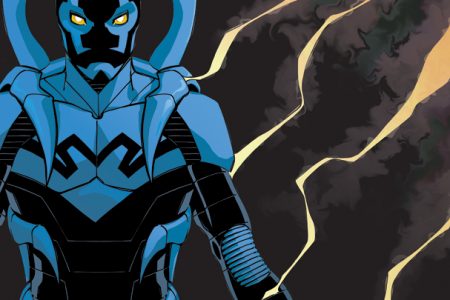I’ve been mentioning that I would talk about Agents of Atlas, which became Atlas, which has now ended after five issues and a convoluted publishing history, so I thought I’d get round to it now after that final issue came out. I first discovered the enjoyment for myself when I read the trade paperback of the mini-series (and named it one of my favourite books that I read that year); however, I didn’t buy the new series because I thought it was going to be a $3.99 series – I didn’t realise that it was only the first issue at that price. Yes, I am an idiot; yes, I regret my stupidity. Fortunately, I was able to pick up nearly all the issues of the ongoing series at a closing down sale of a comic book shop, so that I could buy the crossover mini-series and then Atlas when they came out.
Agents of Atlas was one of several new ongoing series that sprung out of Dark Reign. Under a lovely cover from Art Adams, Jeff Parker and Carlo Pagulayan carry on with the story of our heroes: Jimmy Woo, Ken Hale aka Gorilla Man, Namora, Venus, Bob Grayson alias Marvel Boy/The Uranian, and M-11 the Human Robot (after the briefest and best introductory page ever). Jimmy Woo is the new ruler of the Atlas Foundation, an evil organisation, but he is pretending to be the bad guy so that he can use it as a force for good, which means that they come into conflict with Norman Osborn in his new role as head of HAMMER. This allows for a dialogue where Osborn tells us all about our protagonists (for readers who are unaware), very important for a first issue. After the first issue, which has a back-up story involving the agents and Wolverine, the next few issues have two stories occurring simultaneously, one in the present illustrated by Pagulayan (and some issues by Clayton Henry) and one in the past illustrated by Gabriel Hardman, which obviously are connected. There are appearances from the New Avengers and the Hulk, but Parker is interested in developing the specific story of the Atlas Empire – the Dragon Corridors, the talking dragon Lao (who is advisor to the head of the Atlas Foundation but who has secret plans of his own), the nomination of Temugin (son of the Mandarin) as the second in command of Atlas by Lao and who becomes part of the team, and Jade Claw (Jimmy’s former girlfriend and now head of the Great Wall) attacking the Atlas Foundation.
The series ended with issue 11, but continued in X-Men Vs Agents of Atlas, a two-issue limited series where our team infiltrate the X-Men’s home to access Cerebra to locate Venus, who is missing – there is fighting, naturally, both at the X-Men’s home and in the secret city home of the Atlas Empire, before Namor brings things to a conclusion because he is friends to both teams. And, of course, the agents had met the old X-Men, because it wouldn’t be an Atlas story without some flashbacks. The Agents of Atlas locate Venus, who has been kidnapped by the actual goddess Aphrodite for stealing her name, impersonating her and taking away her worshippers.
 Then, the story of Atlas continues as a back-up strip itself in the pages of The Incredible Hercules, in the Assault on New Olympus storyline (the special and issues 138–141), which sees the team meeting the actual Aphrodite and Venus being crowned the actual Goddess of Love (she was a siren), in a story illustrated by Hardman that connects with the Hercules story. After this, the Agents of Atlas were back in a four-issue mini-series with the Avengers, Avengers Vs Atlas, illustrated by Hardman again (although with various artists on back-up stories), where Atlas meet the original Avengers due to temporal anomalies, thus having the flashbacks as part of the present storyline, which is a nice touch.
Then, the story of Atlas continues as a back-up strip itself in the pages of The Incredible Hercules, in the Assault on New Olympus storyline (the special and issues 138–141), which sees the team meeting the actual Aphrodite and Venus being crowned the actual Goddess of Love (she was a siren), in a story illustrated by Hardman that connects with the Hercules story. After this, the Agents of Atlas were back in a four-issue mini-series with the Avengers, Avengers Vs Atlas, illustrated by Hardman again (although with various artists on back-up stories), where Atlas meet the original Avengers due to temporal anomalies, thus having the flashbacks as part of the present storyline, which is a nice touch.
After these mini-series and being a back-up strip, Parker was given another chance at an ongoing series, as part of The Heroic Age, simply called Atlas. With Hardman as artist of the main story (there are back-ups as per usual, with another artist), this sees the introduction of 3-D Man (Delroy Garrett Jr) becoming part of Atlas – the original 3-D Man was a member of the team from the original What If story. But the ongoing series didn’t last, although it was Parker who decided to pull the plug – he had kept producing quality comics but the comic-buying public didn’t see it that way, and he figured it was time to stop. I guess there’s only so much rejection a man can take, and Marvel had been more than supportive in helping this little book try to achieve something, including three-issue mini-series devoted to Bob and Ken.
This was a shame because Parker was doing lovely work – he had a wonderful cast of interesting characters, including a man who had become a gorilla, a killer robot who was reformed (and didn’t even speak), a telepathic Uranian, an Atlantean with grief issues, a former siren with the control over people; he had original stories with a connection to old comics that it enjoyed linking; he had a lovely way with dialogue and funny lines, Ken in particular; he had great artists (Pagulayan started things with a lovely style, reminding me of Gene Ha, followed by Hardman, who developed into a strong style that reminded me of Michael Lark) and some great covers – see some of them dotted in this post; and he had a great way with storylines that were enjoyable without being excessively angsty or too dependent on current Marvel crossovers, which had good guys doing good things and which were simply fun to read. It would seem that’s a basic thing to do in comic books, but it’s a lot harder to do than you’d think, and I’ll miss the adventures of Jimmy and Ken and Bob and Namora and Venus and M-11. I’m sure they’ll pop up in the Marvel universe at some point – they were characters who are too good not to use again.




